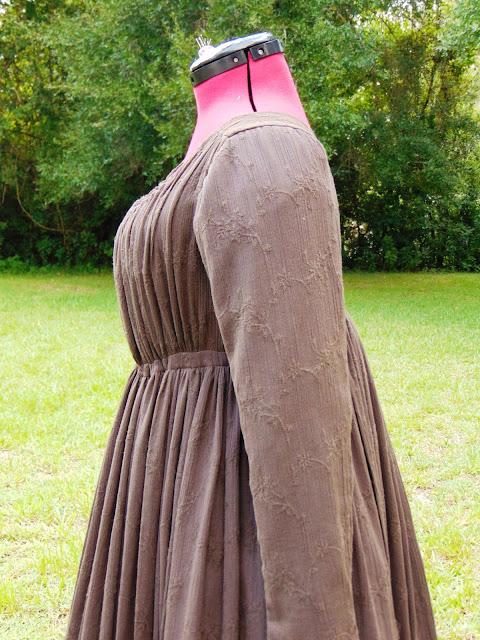Patterns: Laughing Moon #133 Robe en Chemise with significant alterations and construction changes. I basically used it as my jumping off point.
Fabrics: 100% cotton batiste, embroidered, dark brown. Linen/cotton blend for lining, also dark brown. Bolero is 100% silk, mini stripe in coral and cream.
All visible stitching has been done by hand, including the hem and drawstring channels.
Measurements (gown only): *Style allows for a lot of wiggle room in the chest, underbust, and waist.
Chest: 34-38"
Underbust: 30-34"
Waist: Pretty much free, would work as maternity wear.
Hip: Free
Back Width: 13.5"
Hem Length: 41" at front from natural waist. About 44" from the underbust seam. 4" longer at the back.
Hem Width: 180" very fully.
Measurements (bolero): *with center front fully laced closed
Chest: 36"
Underbust: 32/33"
The original pattern has a center back closure and a front with a fixed fitted lining. I did this with a center front opening and fixed back, as well as a loose front lining that overlaps and is pinned in place to fit.
The waistband on the original pattern is also fit specific and fixed, but I decided to cut mine a little longer so it could be drawn in to fit at the front.
I also shorted the bodice pieces to bring the waist seam up higher, making it more early regency as opposed to Chemise and la Reine.
I'm not sure what the proper historical term would be for these little kidney or sausage shaped pads that were often worn at the center back of high waisted gowns, 1790s-1810s. Bustle doesn't seem right, but I've not seen anything else used. I decided to add one in this case to get the silhouette I wanted and also to help alleviate the drag created by the weight of the skirts. I went with a very full, 180" wide skirt portion, so there's a lot of fabric down there lol.































No comments:
Post a Comment